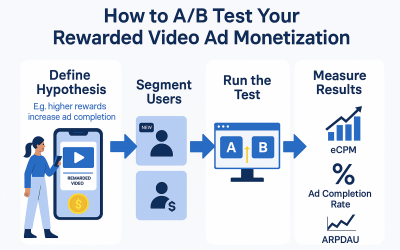Bad Ads: Why Ad Quality Is the Key to Long-Term Monetization
Contents
- 1 The Hidden Threat of Bad Ads
- 2 What Is Ad Quality, Really?
- 3 The Cost of Ignoring Ad Quality
- 4 Why Ad Networks Alone Can’t Solve This
- 5 Fixing Ad Quality Before It Breaks the Industry
- 6 How AppLixir Helps Maintain High Ad Quality
- 7 Future of Ad Monetization Depends on Quality
- 8 AppLixir Summary – Build Trust Before It’s Too Late
The Hidden Threat of Bad Ads
In mobile game monetization and app monetization, developers face an invisible killer. Poor ad quality silently destroys revenue potential through a phenomenon called “retention drag.”
Retention drag occurs when low-quality advertisements drive users away from games and applications. This creates devastating ripple effects that impact every crucial metric. Lifetime value (LTV) plummets. Average revenue per daily active user (ARPDAU) crashes.
The mathematics are brutal yet simple. Bad ad experiences directly correlate with poor user retention. Poor retention decimates long-term monetization potential. When players encounter laggy, irrelevant, or intrusive advertisements, they don’t just skip the ad. They abandon the entire experience.
This isn’t merely an inconvenience. It’s a fundamental threat to sustainable revenue generation. Every negative interaction with advertising content represents potential permanent revenue loss.
Ad quality is not a nice-to-have feature—it’s critical for successful monetization. User acquisition costs continue skyrocketing. Player attention spans keep shrinking. The stakes have never been higher. Tolerance for subpar ad experiences has never been lower.
Leading companies like AppLixir are pioneering new approaches to this challenge. They’re spearheading improvements in ad quality within rewarded video ad ecosystems. Their work proves that prioritizing ad quality builds sustainable, profitable business models.
What Is Ad Quality, Really?
Ad Quality encompasses far more than just visual appeal or creative content. It represents comprehensive evaluation of the entire advertising experience. This includes clarity of presentation, loading speed efficiency, and content relevance. Optimal frequency capping and seamless user experience integration matter too.
When any of these elements fail, the entire monetization strategy suffers.
Poor quality ad experiences manifest in destructive ways. Laggy or crashing video ads create immediate frustration. Users often force-close applications entirely. Irrelevant or deceptive content breaks trust between developers and players. This leads to long-term relationship damage extending beyond single advertising interactions.
Unskippable advertisements destroy natural gameplay flow. Overly frequent interruptions transform entertainment into annoyance. Players begin associating entire platforms with poor experiences.
These negative experiences create direct connections to ad monetization outcomes and accelerated player churn. Users encountering consistent low-quality advertising develop negative platform associations. This leads to decreased engagement, negative reviews, and complete application abandonment.
The impact extends across both mobile and web game environments. Mobile users often have less tolerance for performance issues. Device limitations and data concerns amplify frustrations. Web game players may be more sensitive to intrusive advertising. Regardless of platform, poor ad quality directly undermines monetization success.
The Cost of Ignoring Ad Quality
The financial impact of neglecting ad quality extends beyond immediate user complaints. When examining game and app metrics, damage becomes apparent across every performance indicator.
Increased churn rates represent the most immediate consequence. Frustrated users simply stop returning to applications delivering poor advertising experiences consistently. Lower engagement levels follow naturally from increased churn. This creates compounding negative effects.
As active user numbers decline, overall value propositions to advertisers decrease. This leads to reduced demand and lower CPMs. Poor ad experiences reduce engaged user quantities. This makes remaining inventory less valuable to potential advertisers.
Rewarded video completion rates suffer particularly severe impacts from poor ad quality. Users encountering laggy, irrelevant, or technically problematic rewarded advertisements complete viewing experiences less frequently. This happens even when valuable in-game rewards are at stake. This dramatically reduces rewarded video monetization strategy effectiveness.
Ad fatigue represents another critical consequence of poor quality experiences. Users consistently encountering low-quality advertisements develop negative associations with advertising content generally. This leads to decreased engagement even with high-quality ads.
Industry research suggests telling statistics. A 5% drop in retention can result in 20% lifetime value decrease. This highlights severe financial implications of seemingly small quality issues.
These problems directly affect mobile game advertising revenue and rewarded video ads earnings. Long-term financial consequences far outweigh any short-term gains from accepting lower-quality advertising inventory. The cost isn’t just measured in immediate revenue loss. It’s reflected in permanent user relationship damage and platform reputation harm.
Why Ad Networks Alone Can’t Solve This
Traditional ad networks operate under fundamentally different priorities than developers focused on long-term retention. Most networks prioritize fill rate and CPM optimization above all other considerations. This creates systemic misalignment between network incentives and developer needs.
High fill rates and competitive CPMs appear attractive in isolation. However, they often come at player experience expense and long-term monetization sustainability cost.
Developers require visibility and control over ad sources to maintain quality standards. Traditional ad networks often operate as black boxes. They provide limited insight into specific advertisements being served to users. This transparency lack makes identifying and eliminating problematic ad sources nearly impossible.
Many demand sources within ad networks allow low-effort creatives. These prioritize quick production over quality execution. Such advertisements often feature misleading gameplay footage, poor audio quality, or deceptive promises. They destroy user trust in advertised products and hosting platforms.
When users feel deceived by advertising content, they transfer negative sentiment to host applications. This creates lasting damage beyond individual ad experiences.
Ad exchanges frequently struggle to filter out junk or scammy advertisements quickly enough. The sheer advertising content volume makes manual review challenging. Automated systems often fail catching subtle quality issues that significantly impact user experience. By the time problematic ads are identified and removed, substantial user retention damage may have occurred.
This systemic problem requires solutions extending beyond traditional ad network capabilities. More sophisticated approaches to quality control and user experience optimization are essential.
Fixing Ad Quality Before It Breaks the Industry
Ad quality isn’t merely a technical challenge—it’s a fundamental monetization strategy. This determines long-term business sustainability. Treating advertising quality as an afterthought represents critical strategic error. It undermines all other monetization efforts.
Proactive developers and publishers should implement comprehensive monitoring systems. These should track user complaints and establish effective feedback loops. Quality issues must be identified before they escalate.
This includes analyzing user reviews and monitoring support tickets related to advertising experiences. In-app feedback mechanisms should allow users reporting problematic advertisements directly.
Utilizing platforms with robust ad vetting systems represents another crucial step. These systems should include automated screening for technical issues. Human review processes for evaluating content appropriateness and user experience impact are essential. Additional investment in quality control pays dividends through improved user retention.
Controlling demand sources requires systematic blocking of low-quality ads. This demands ongoing vigilance and sophisticated filtering systems. Maintain blocklist of problematic advertisers. Implement content category restrictions. Establish performance thresholds that automatically remove underperforming ad sources.
Analyzing ad session length and drop-off rates provides valuable quality impact insights. Users consistently abandoning applications during or immediately after advertising experiences indicates fundamental quality issues. These metrics should be monitored continuously and guide quality improvement efforts.
The ultimate goal involves optimizing user experience while maximizing ad revenue. Recognize that these objectives are complementary rather than competing priorities. High-quality advertising experiences lead to increased user engagement, higher completion rates, and superior monetization outcomes.
How AppLixir Helps Maintain High Ad Quality
AppLixir’s innovative approach represents fundamental shift in rewarded video ads integration. Their commitment to human-reviewed demand sources ensures every advertisement meets rigorous quality standards. This happens before reaching end users, eliminating common automated approval system problems.
Transparent reporting and sophisticated ad filtering provide developers with unprecedented visibility into advertising inventory. This transparency enables data-driven decisions about ad source maintenance, modification, or elimination. Decisions are based on actual performance data and user feedback rather than theoretical metrics.
AppLixir focuses on rewarded video ads that don’t break immersion. This addresses one of modern game monetization’s most critical challenges. Ensuring advertising content complements rather than disrupts gameplay experiences is crucial. This enables developers implementing monetization strategies that enhance rather than detract from user satisfaction.
AppLixir’s ad quality model directly supports improved user retention through careful advertising content curation. Rigorous technical performance testing matters too. Users encountering consistently high-quality advertising experiences remain engaged with applications over extended periods. This leads to higher lifetime value and increased monetization potential.
Higher eCPMs result naturally from improved user engagement and completion rates. Users trusting that advertising content will be relevant, technically sound, and respectfully integrated engage more fully. They’re more likely to complete rewarded video opportunities. This leads to improved performance metrics attracting premium advertisers.
Cleaner integration into popular development platforms ensures implementing high-quality advertising doesn’t require extensive technical overhead. Unity, HTML5, and web games integration works seamlessly. AppLixir’s tools work within existing development workflows while maintaining rigorous quality standards.
Future of Ad Monetization Depends on Quality
Successful long-term monetization trajectory increasingly depends on maintaining rigorous ad quality control standards. Users become more sophisticated and less tolerant of poor advertising experiences. Platforms failing to prioritize quality will face insurmountable competitive disadvantages.
Incentivized ads continue evolving into comprehensive rewarded ecosystems providing genuine user value. This represents fundamental shift from interruption-based advertising models toward value-exchange systems. These benefit all participants: users receive meaningful rewards, advertisers reach engaged audiences, developers generate sustainable revenue.
Industry-wide pushback against spammy monetization practices reflects growing recognition. Short-term revenue optimization often undermines long-term business sustainability. Users, advertisers, and platform holders increasingly demand higher advertising quality standards. This creates market pressure rewarding quality-focused approaches.
Modern gamers have become significantly more ad-aware and intolerant of poor user experiences. They understand advertising’s role in supporting free-to-play models. However, they expect advertising content meeting reasonable standards for quality, relevance, and respectful integration. Platforms failing to meet these expectations face rapid user attrition.
The fundamental argument remains clear. High-quality ad experiences create sustainable revenue models adapting to changing market conditions and user expectations. Investing in advertising quality represents investment in long-term business viability rather than cost center reducing short-term profitability.
AppLixir Summary – Build Trust Before It’s Too Late
The central thesis bears repeating. Fixing ad quality represents the smartest monetization move modern developers and publishers can make. User acquisition costs continue rising while user attention spans decline. Every advertising content interaction represents either relationship-building opportunity or permanent user loss risk.
The temptation to prioritize short-term CPM gains over long-term LTV protection represents fundamentally flawed strategy. This undermines sustainable business growth. Accepting lower-quality advertising inventory might provide immediate revenue benefits. However, long-term costs in user churn, reduced engagement, and damaged reputation far outweigh temporary gains.
AppLixir stands ready to support developers with monetization tools prioritizing quality and trust above short-term revenue optimization. Their comprehensive ad quality management approach provides developers with necessary tools, insights, and support. This enables implementing sustainable monetization strategies benefiting users, advertisers, and developers equally.
The choice facing today’s developers is straightforward. Invest in advertising quality now, or face increasingly severe consequences later. User dissatisfaction and competitive disadvantage await those who delay. Companies recognizing advertising quality as core business priority will build sustainable competitive advantages.
Those treating it as an afterthought will struggle maintaining relevance in increasingly quality-conscious marketplaces.
Talk to AppLixir today about improving your rewarded ad experience. Discover how prioritizing ad quality can transform your monetization strategy. Turn it from necessary evil into genuine competitive advantage.



